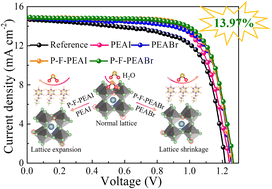The synergistic effect of defect passivation and energy level adjustment for low-temperature carbon-based CsPbI2Br perovskite solar cells†
Abstract
Carbon-based CsPbI2Br perovskite solar cells (PSCs) have attracted widespread attention due to their low cost and superior thermal stability. Unfortunately, the bulk defects and interfacial energy level mismatch limit the improvement of device performance. To solve the above issues, we introduce aromatic phenylethylammonium halides (PEAI and PEABr) and their fluorinated derivatives of 4-fluorophenylethylammonium halides (P-F-PEAI and P-F-PEABr) as a passivation layer to post-treat low-temperature CsPbI2Br films. Benefiting from reduced perovskite defects and better energy level alignments, the charge non-radiative recombination is effectively suppressed, and the hole extraction is promoted. Compared with the reference PSCs, the optimized devices achieve a maximum power conversion efficiency (PCE) of 13.97%. To the best of our knowledge, it should be one of the highest PCEs reported among those of low-temperature carbon-based CsPbI2Br PSCs. In addition, nonencapsulated devices exhibit improved moisture and thermal stability in ambient air.



 Please wait while we load your content...
Please wait while we load your content...